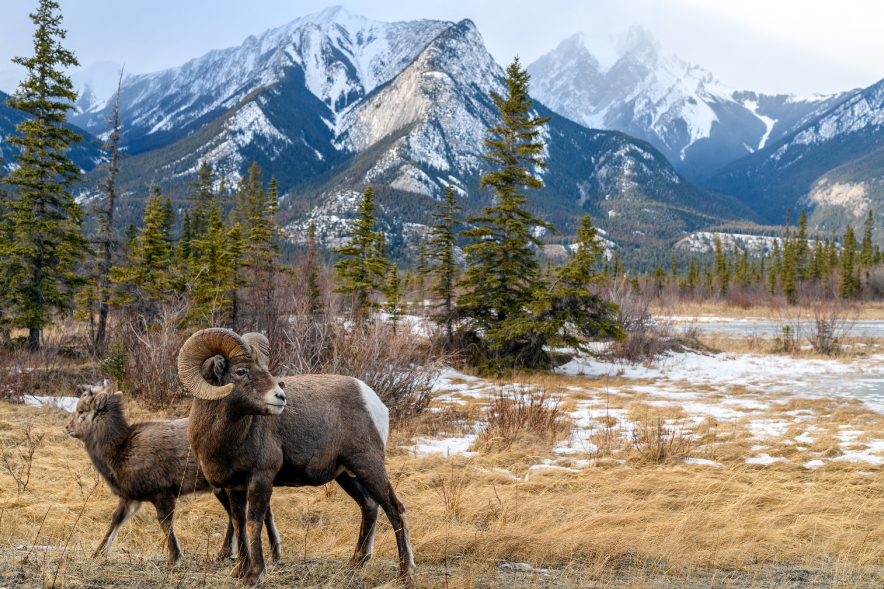A Closer Look at North America’s Majestic Species
In the vast and rugged landscapes of the American West, one iconic species stands out—the Rocky Mountain Bighorn. Renowned for its majestic appearance and impressive horns, this magnificent creature captivates the imagination of wildlife enthusiasts and hunters alike. With its remarkable adaptability to high-altitude environments and its unique behavioral patterns, the Rocky Mountain Bighorn continues to be a symbol of resilience and natural beauty. In this blog entry, we will delve into the world of the Rocky Mountain Bighorn, exploring its habitat, behavior, conservation efforts, and the awe-inspiring experience of encountering these grand animals in their natural domain.
The Rocky Mountain Bighorn, scientifically known as Ovis canadensis, is a subspecies of bighorn sheep native to the Rocky Mountains of North America. Among the various subspecies, it is the largest and most iconic, with its striking curling horns that can grow to impressive lengths. These magnificent horns not only serve as a symbol of strength and dominance but also play a crucial role in territorial disputes and courtship rituals.
Native to the high-altitude regions of the Rockies, the Rocky Mountain Bighorn has adapted to its rugged habitat with remarkable resilience. Its ability to thrive in extreme environments showcases its remarkable evolutionary traits. These animals are built for the mountains, with strong, muscular bodies and specialized hooves that provide excellent traction on rocky terrains. Their keen senses of sight and hearing further contribute to their survival in challenging landscapes.
Understanding the behavior and social dynamics of the Rocky Mountain Bighorn is key to appreciating their complex lives. Bighorn sheep live in hierarchical societies, with dominant rams leading groups of ewes and their young. During the breeding season, known as the rut, fierce battles between rams occur as they compete for mating rights. These spectacular displays of dominance involve head-on collisions and the echoing clash of their massive horns, leaving spectators in awe of nature’s power.
The rugged and often remote habitats of the Rocky Mountain Bighorn pose challenges for both researchers and enthusiasts seeking to study or observe them. To gain insights into their behavior and population dynamics, scientists employ various methods, including radio collaring, observation, and genetic analysis. These efforts help researchers understand the factors influencing their population size, movement patterns, and genetic diversity.
Conservation of the Rocky Mountain Bighorn is of utmost importance to ensure the survival of this remarkable species. Due to factors such as habitat loss, disease transmission, and overhunting in the past, bighorn populations faced significant declines. However, dedicated conservation initiatives and stringent hunting regulations have played a crucial role in their recovery. Wildlife management agencies, conservation organizations, and hunters have collaborated to protect critical habitats, establish conservation programs, and promote sustainable hunting practices that benefit both the bighorn population and local communities.
Preserving the bighorn’s habitat and managing their populations require ongoing efforts. Conservationists work tirelessly to identify and mitigate threats, such as the spread of diseases like pneumonia, which can devastate bighorn herds. Efforts to minimize human disturbance in their habitats, implement responsible land management practices, and engage in public education further contribute to the long-term conservation of these majestic creatures.
For those fortunate enough to witness the Rocky Mountain Bighorn in their natural environment, the experience is nothing short of awe-inspiring. Whether through guided wildlife tours, hiking expeditions, or hunting adventures, encountering these majestic animals up close leaves a lasting impression. The sight of a magnificent ram atop a rocky precipice or the thunderous echo of their powerful clashes during the rut is a testament to the wild beauty of nature.
In conclusion, the Rocky Mountain Bighorn stands as a symbol of resilience, natural beauty, and the intricate balance of ecosystems in the American West. Understanding their habitat, behavior, and conservation needs is crucial for ensuring their survival and the preservation of their unique ecological role.
As we continue to appreciate the awe-inspiring presence of the Rocky Mountain Bighorn, it is our responsibility to contribute to their conservation. Supporting organizations dedicated to bighorn conservation, participating in responsible hunting practices, and advocating for the protection of their habitats are essential steps we can take. By fostering a deeper understanding of these majestic creatures and promoting their conservation, we can secure a brighter future for the Rocky Mountain Bighorn and ensure that future generations have the privilege of witnessing their remarkable existence.
So, let us continue to explore, learn, and appreciate the wonders of the Rocky Mountain Bighorn—a true symbol of the untamed spirit of the American West. Together, we can work towards their protection, ensuring that these magnificent creatures continue to roam the rugged landscapes of the Rocky Mountains for generations to come.
We Encourage and Welcome Comments
If you enjoyed this post, we would be very grateful if you’d help it spread by emailing it to a friend or sharing it on Twitter or Facebook. Thank you!





